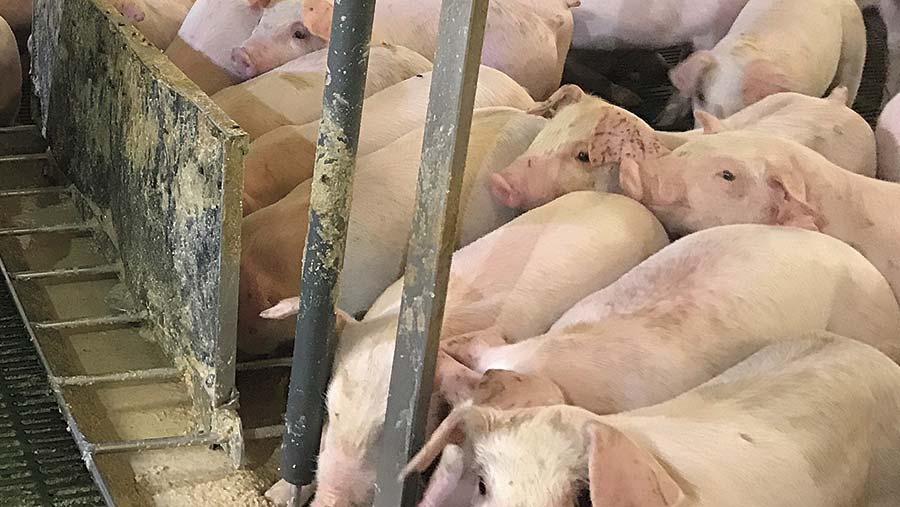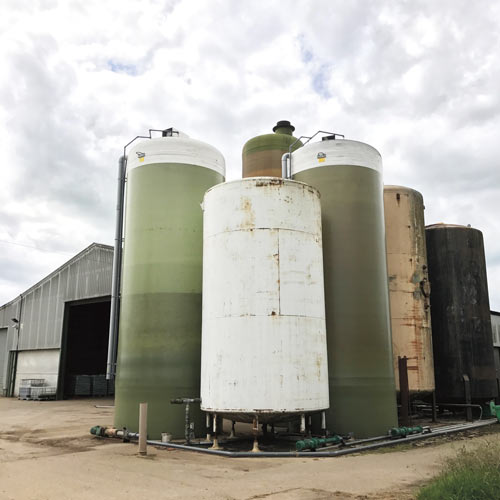Liquid feeding weaners improves pig finishing performance
Pig farmer Matthew Rathbone says changing to feeding liquid feed has cut ration costs and improved performance on his 240-breeding sow unit in Rugby.
The third-generation farmer, runs 80ha (200 acres), finishes 5,550 pigs annually for Morrisons, and produces barley, wheat and fodder beet as part of an arable enterprise.
Previously, Mr Rathbone was feeding a dry ration, but decided to move over to liquid feeding when a new unit was built and it was fitted with a state of the art, computerised, liquid feeding system.
He says the £100,000 investment in the liquid feed system has paid dividends and he is now reaping the rewards of reduced feed and labour costs as well as improved pig performance.

See also: Liquid feeding ups finisher weights
“We’d been considering building a new unit for a while but finally took the plunge in 2000 and it was at this point that we made the decision to switch from dry to liquid feeding,” explains Mr Rathbone.

Liquid feed storage tanks
At the time, the primary aim was to reduce the cost of production. Therefore, addressing the largest on-farm cost, feed – which accounted for approximately 70% of input costs – was really important, he adds.
“Our nutritionist encouraged us to introduce liquid feed into the ration. He considered it be a proven way to drive down feed costs, due to its relative nutritional value, as most liquid feeds are co-products.
“Not only this, but the automated system was proven to save time in terms of labour. And although the initial investment cost was significant at £100,000, we felt it was the right route to take long term.”
The rations
Key considerations when liquid feeding
- The capital cost of converting to a liquid feeding system can be high but the long-term benefits should be considered
- Liquid feeds need to be managed and stored correctly to minimise the risk of them fermenting
- Effluent output can be higher when liquid feed is used because of the extra volume of water consumed by the pigs
Seventeen years on, Mr Rathbone is a true convert to liquid feeding. He reckons he has reduced costs of production by £1.80 a pig, by better performance and lower feed costs.
The units’ dry sow, lactating sow, weaner and grower rations are all formulated based on the inclusion of four liquid co-products, as well as home-grown wheat and barley.
These four products include soyfeed, whey Permeate, potato cream and Proflo, a wheat distillery syrup and, more recently (in the last five years), a wheat distillery product has been added.
Wheat and barley, which is grown and milled on-farm, are included at varied inclusion rates, along with a concentrate balancer to ensure sufficient vitamins and minerals are provided.
He notes additional ingredients are often added to the “base” rations to ensure maximum productivity and performance every stage.
“When our piglets are weaned at four weeks old, they are moved straight on to a liquid diet. However, a grower mix is added to the ‘base’ ration to ensure nutritional requirements are met to aid efficient growth.” (See Table 1: Breakdown of rations for full ration specifications, and costs below).
Performance improvements
“This obviously drives up overall ration costs, but the increased benefits in daily liveweight gains (DWLG) outweigh the costs,” says Mr Rathbone.
Breakdown of rations |
|||
| Dry sow | Lactating sow | Weaner/grower | Finisher |
| Barley | Barley | Barley | Barley |
| Wheat | Wheat | Wheat | Wheat |
| Bulk soya bean oil | Bulk Hipro soya | Bulk Hipro soya | Bulk Hipro soya |
| Potato cream | Bulk soya bean oil | Bulk soya bean oil | Bulk soya bean oil |
| Wheat distillery syrup | Potato cream | Evaporated yeast enriched wheat syrup | Potato cream |
| Whey permeate | Evaporated yeast enriched wheat syrup | Wheat distillery syrup | Evaporated yeast enriched wheat syrup |
| Soyfeed | Wheat distillery syrup | Whey permeate | Wheat distillery syrup |
| Pig finisher | Whey permeate | Soyfeed | Whey permeate |
| Lactating sow mixer | Soyfeed | Grower mix | Soyfeed |
| Lactating sow mixer | Pig finisher | ||
| £175/t | £264/t | £425/t | £175/t |
“Our weaner to grower average DLWG is 510g/day which is fantastic. And I believe that we can attribute this to liquid feeding, and the inclusion of a high protein wheat distillery syrup.
“Liquid feeding at the weaning stage isn’t common practice; in fact we’re probably one of the few farms that do it. However, it’s a really smooth transition and offers a more natural diet compared to dry feeding when piglets are first taken off the sow.”
In fact, Mr Rathbone says because intakes are higher in the earlier days it is leading to an average finishing age of 20 weeks with weights averaging 112kg liveweight.
Prior to liquid feeding, pigs were taking a week longer to finish and were growing about 100g less a day on the dry ration.
Cost savings
Mr Rathbone attributes using wheat distillery syrups to successful pig performance and a reduction in feed costs. “Feeding a wheat distillery syrup, in replace of traditional protein sources such as soya and rape meal, is much more cost effective.
“However, at 40% crude protein (on a DM basis) you’re not compromising on protein quality, which is key as this element of the diet is essential for efficient growth. It’s also a high energy source at 14MJ ME/kg DM which helps sustain development and maintain growth rates, enabling us to achieve target weights.
“The provision of this energy also helps to improve feed conversion ratios (FCR) which means you’re gaining more growth per unit of feed, which further drives down costs.”

